ROMANIA
History

History

Cities in ROMANIA
| Brasov | Bucharest |
History
Antiquity and Middle Ages
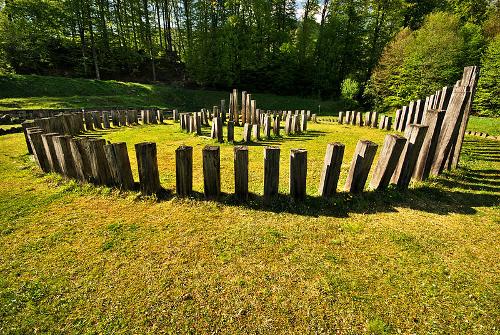 Stone circle from the time of the Dacians, RomaniaPhoto: Calin Jorza CC 3.0 Romania no changes made
Stone circle from the time of the Dacians, RomaniaPhoto: Calin Jorza CC 3.0 Romania no changes made
Today's Romanian territory was founded in the first century BC. inhabited by the Dacians, an Indo-European Thracian people. This people was a close neighbor of the Romans who settled in the second century AD. felt threatened by the increasingly powerful Dacians, especially under King Decebalus. It took Emperor Trajan two campaigns to eliminate Decebalus and subdue the Dacians.
After this, Romania was overrun with settlers who mixed with the native population. Towards the end of the third century, the Romans left again because of the increasingly pushing barbarians.
After the retreat of the Romans, Romania was populated by various nomadic peoples such as the Huns and the Visigoths, and from the 7th century by Slavs who invaded Romanian territory from the north and mixed with the Daco-Romans and the Magyars who joined in the 9th century settled in the Pannonian plain. In the 11th century they made the area northwest of the Carpathians part of the Hungarian kingdom. This area would later be called Transylvania. The first Romanian principalities were formed in the mid-14th century: Wallachia (Romanian: Tara Româneasca) and Moldavia (Moldova).
Ottoman rule
From the south the young Romanian states were attacked by a very powerful enemy, the Ottomans or Ottomans (Turks) who conquered Constantinople in 1453. Constantinople became the capital of the Ottoman Empire and the center of Islam. Only by paying a lot of money the Romanians managed to prevent their territory from being occupied. Furthermore, the sovereignty of the sultan was accepted by the Romanian monarchs, allowing them to keep their own laws, social institutions and political organs. This is the main reason that there are practically no mosques in Romania.
However, the economic pressure on the Romanians was increasing, and it was therefore not surprising that the Romanians repeatedly tried to liberate themselves from the Turks. However, this hardly succeeded and often only lasted for a short period of time. In the 15th century, Stefan cel Mare managed to rule Moldavia for 48 years and to win dozens of battles against the Turks. Michael the Brave (Romanian: Mihai Viteazul) was the prince of Wallachia, and in 1600 he managed to unite under his authority the three later provinces of Romania, Transylvania, Wallachia and Moldavia.
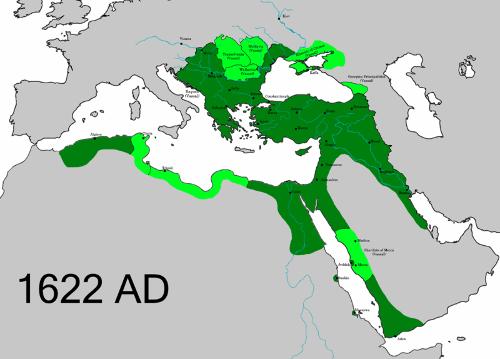 Ottoman Empire in 1622, RomaniaPhoto:Chamboz CC 4.0 no changes made
Ottoman Empire in 1622, RomaniaPhoto:Chamboz CC 4.0 no changes made
The Ottomans reached the height of their power in the eighteenth century and the Romanians were trapped between the Habsburg and Russian Empires. Power over Wallachia and Moldavia was further confirmed by the appointment of a number of Greeks as rulers of the said kingdoms. These Greeks came from the Fanar or Fener district of Istanbul and were therefore called Fanariots. These Fanariots ruled in Moldavia from 1711 and from 1716 in Wallachia. Positive was the cultural boom that arose due to the Greek influences. Serfdom was also abolished in the mid-eighteenth century and important legal and administrative reforms were introduced.
In the course of the eighteenth century the Ottoman influence diminished, but Russian influence increased again. In 1774, a treaty was signed in Küçük Kaynarca, making the Russians patron of the Orthodox Christians in the Ottoman Empire. The Russians took this opportunity to annex the eastern part of Moldavia (Bessarabia). Meanwhile, Transylvania was under the rule of the Habsburgs and the many Romanians were dominated by the Hungarian aristocracy and German citizens.
Around 1700, many Romanian Orthodox clergymen entered into a union with the Catholic Church of Rome, giving Romanian clergy the same status as Roman Catholics. In the second half of the eighteenth century there was a movement that aimed for recognition of the Romanians as an equal population group. This movement was led by Bishop Inochentie Micu-Klein and was known as the “Scoala Ardeleana” or the Transylvanian School. However, a petition, presented in 1791 to the Austrian Empress Maria Theresa, was unsuccessful.
Russo-Turkish rule
In 1821 the Greek struggle for the independence of the Ottoman Empire started from Moldavia. Inspired by this, the soldier Tudor Vladimirescu started a revolt against the Greek lords of the principalities. However, this uprising led to Russo-Turkish occupation of all of Romania, but resulted in Wallachia and Moldavia being once again ruled by native princes since 1821.
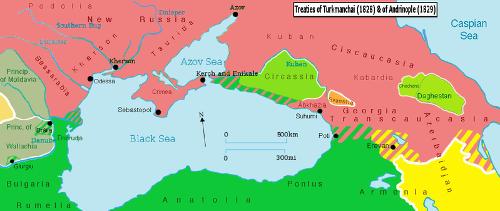 Territorial changes after the Treaty of Adrianopolis, RomaniaPhoto: Spiridon Ion Cepleanu CC 3.0 Unported no changes made
Territorial changes after the Treaty of Adrianopolis, RomaniaPhoto: Spiridon Ion Cepleanu CC 3.0 Unported no changes made
With the Treaty of Adrianopolis in 1829, Russian influence grew stronger and the Romanian principalities became in effect Russian protectorates and the role of the Turks was played out. The commander of the Russian troops, Pavel Kiseleff, introduced the “Regulament Organic”, a kind of constitution, in the early 1930s. The Romanian population at this time increasingly turned to the west, and the revolutions that occurred in Europe in 1848 also affected the Romanian principalities.
The leaders of the revolution in Romania were called “pasoptisti” (forty-eight), and they wanted a liberal constitution and far-reaching social reforms. The revolution in Moldova was quickly suppressed, but a revolutionary government remained in power for several months in the Wallachian capital, Bucharest. After this, Bucharest was occupied by a Turkish expeditionary force and the rest of Wallachia was occupied by the Russians. In Transylvania, the revolution ended in an ethnic conflict between the Hungarians, who under the leadership of Lajos Kossuth, declared an independent Hungarian state, and the Romanian Avram Iancu, who was of course strongly opposed to this.
A battle ensued between these two groups from which only the Austrian rulers benefited. In 1849 the revolutionaries got the worst of it.
Romania independent
The following years were dominated by the struggle for unification of Moldavia and Wallachia. Russia lost the Crimean War and as a result the Romanian principalities came under the protection of the Western powers. The intention was that each principality would remain a separate country and thus serve as buffer states between Austria, Turkey and Russia. However, the Romanians were strongly against this and in 1859 elected Colonel Alexandru Ioan Cuza as ruler of both Wallachia and Moldavia.
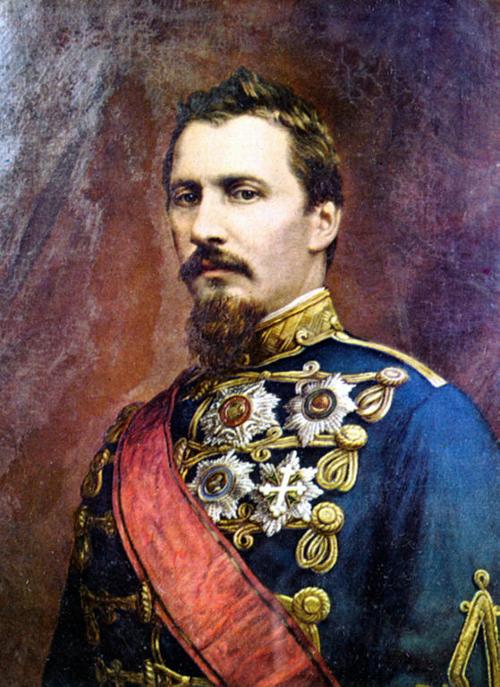 Alexander Ioan Cuza, RomaniaPhoto: Public domain
Alexander Ioan Cuza, RomaniaPhoto: Public domain
With this the unification of the principalities under the name of Romania became a fact. Cuza was a strong supporter of social and political renewal but hardly had time to realize his ideas. In 1866 he was deposed by an alliance of many opponents. After Cuza, Romania was given a foreign head of state: Prince Carol I of Hohenzollern-Sigmarinen, who would rule until 1914 and positively influence Romania's development and modernization.
A new constitution was also passed in 1866 and would remain in effect until 1923. During the Russo-Turkish War of 1877-1878, Romania declared itself completely independent from Turkey and in 1881 the Great Powers also recognized Romania's independence. After this, Carol was crowned king. Transylvania, meanwhile, had lost its autonomous status with the formation of the Austro-Hungarian Dual Monarchy in 1867.
The official policy in Hungary was that all residents of the area were considered Hungarians, including the many Romanians who lived here. Despite this situation, a so-called “Triple Alliance” was concluded with Germany and Austria-Hungary, which hoped to be able to counterbalance the Russian drive for expansion. It is clear that relations with Austria-Hungary did not go smoothly. The covenant was therefore jealously hidden from the ordinary pro-French population. During that period, political relations ensured an alternation between conservative and liberal governments.
First and Second World War
The period up to 1914 was one of great stability and progress, despite the often great poverty in which the peasant population lived. In 1907, a great peasant uprising broke out, killing many thousands of peasants. In the First Balkan War (1912-1913) Romania remained neutral, but in the Second Balkan War they joined the coalition against Bulgaria.
Romania acquired a number of Bulgarian districts after the Peace of Bucharest in 1913, which, however, had to be returned at the start of the Second World War in 1940. World War I broke out in 1914 and Romania initially remained neutral. In 1916 they nevertheless joined the Allies, hoping for reunification with Transylvania. The capital Bucharest was occupied by the Germans, but with the help of Russian units it was possible to prevent the entire country from being occupied. After the revolution in their country, the Russians withdrew from the battle, after which Romania was forced in May 1918 to make peace with the so-called Axis powers of Germany, Austria-Hungary and Turkey. When the Allies seemed to win the battle, however, they rejoined the Allies.
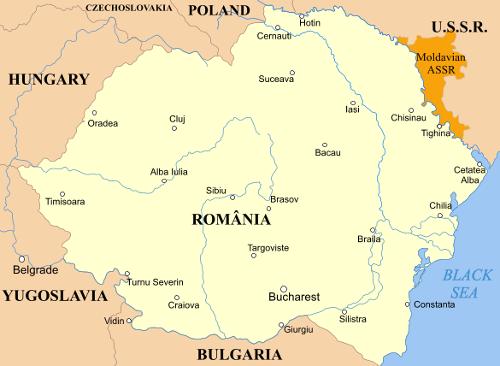 Greater Romania between the warsPhoto: Bogdangiusca CC 3.0 Unported no changes made
Greater Romania between the warsPhoto: Bogdangiusca CC 3.0 Unported no changes made
After the war, Romania acquired many territories: Transylvania, the Banate of Hungary, Bucovina, and Bessarabia. The territory doubled and from then on was called Greater Romania. The population increased to 16 million people, one third of which consisted of non-Romanians. In the Interbellum, power was alternated between the Liberal Party and the Peasant Party. Industrialization got off to a good start, causing industrial production to double between 1923 and 1938.
In 1923 a new constitution was introduced which mainly protected the interests of the industrial and economic middle class. Furthermore, a major agricultural reform took place as a result of which a lot of agricultural land was transferred from large landowners to small farmers. In the 1930s, the Romanian economy also suffered greatly from the global economic crisis and the rise of dictatorial regimes elsewhere in Europe also left its mark on Romania. King Carol II instituted a royal dictatorship in 1938 and banned all political parties. Only about fifty years later would parliamentary democracy be restored.
In the Second World War, Romania initially took a neutral position, but after the pact between Hitler and Stalin and the defeat of France, it was forced to cede large parts of the country. Northeastern Transylvania was joined by Hungary, and Bessarabia and Northern Bucovina were incorporated into the Soviet Union. As a result, Carol II resigned and was succeeded by his son Mihai, while de facto government power passed into the hands of the military dictator Ion Antonescu.
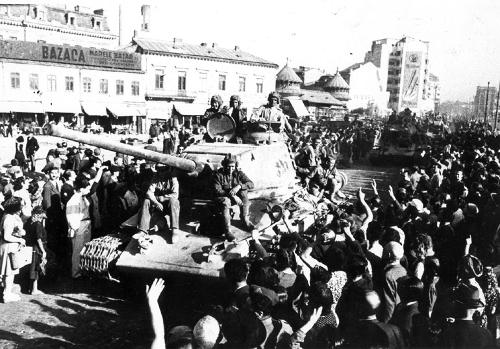 Red Army is greeted in Bucharest, RomaniaPhoto: Public domain
Red Army is greeted in Bucharest, RomaniaPhoto: Public domain
He sided with Nazi Germany and took part in the war with the Soviet Union in order to reclaim the lost territories. This failed completely and not much remained of the Romanian army after the Battle of Stalingrad. In order to avoid occupation by the armies of the Soviet Union, the democratic opposition tried in vain to make peace with the Allies.
On August 23, 1944, King Mihai had Antonescu arrested and Romania joined the Allies. After the war, Romania was not declared co-victor and only Transylvania came back to Romania. Bessarabia and Bucovina remained Soviet territory. The whole country was now occupied by the Red Army and the communists had taken over. All democratic parties were banned and the party leaders were put in prison. On December 30, 1947, King Mihai was forced to abdicate and the People's Republic of Romania was proclaimed on the same day. Dictator Antonescu was executed in 1948 by the communist rulers at the time.
People's Republic of Romania
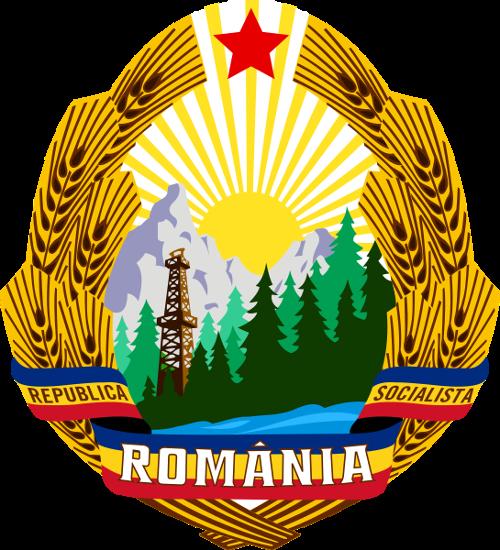 Coat of arms of the Socialist Republic of RomaniaPhoto: Public domain
Coat of arms of the Socialist Republic of RomaniaPhoto: Public domain
Due to communist rule Romania became completely isolated from the West. The totalitarian regime became a clone of the Soviet model and in 1948 a constitution was passed in which all power fell into the hands of the communist party. Banks and industrial enterprises were nationalized and all private initiative was rejected, including religious and cultural initiatives.
Emphasis was placed on the development of (heavy) industry and that at one point made Romania one of the largest steel producers in the world. The fact that coal and iron ore had to be imported for this was considered completely normal. The agricultural land was forcibly expropriated and collectivized.
In the late 1940s and 1950s, Romania became permanently entangled in the Soviet web. Hundreds of thousands of Democrats were imprisoned or put in labor camps. And opposition to this was crushed by the Securitate, the secret service. The population remained pro-Western all that time, but anti-communist partisans had to give up their fight in the early 1960s. The first post-war leaders were members of the so-called Moscow group: communists, often not even ethnic Romanians, who had lived in the Soviet Union for a long time and only returned after the communist coup.
It was not until 1952 that the native communists came to power and the Moscow group was sidetracked by the party leader Gheorghe Gheorghiu-Dej. A period of relaxation began in the 1960s. The standard of living rose somewhat, more consumer goods came onto the market, and cultural contacts were even possible with the West. Politically, however, there was no real liberalization yet, although not all Soviet models were pursued anymore. A tense situation also arose between Gheorghiu-Dej and the Soviet party leader Khrushchev.
The Soviets wanted Romania to stop concentrating on producing agricultural products and raw materials for the other members of the Eastern bloc. Gheorghiu-Dej refused to implement this plan and even distanced himself from the Soviet Union. After this, the Soviet Army left Romania and in 1964 the Romanian Communist Party adopted an official declaration of independence from the Soviet Union.
Period Ceausescu: the Devil Empire
Party leader Gheorghiu-Dej died in 1965 and was succeeded by Nicolae Ceausescu. Also in 1965, a new constitution was passed declaring Romania a socialist republic. Ceausescu's policy was to operate more and more independently of the Soviet Union; for example, he refused to provide troops to put an end to the "Prague Spring" in August 1968. This made him popular with the Western powers and relations with the Soviet Union were hardly affected by Ceausescu's policies. It was well understood that the Communist Party would remain the most powerful and that Romania would always remain a member of the Warsaw Pact.
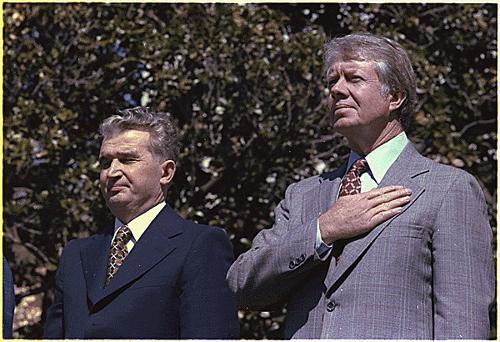 Ceaucescu and Carter in 1978, RomaniaPhoto: Public domain
Ceaucescu and Carter in 1978, RomaniaPhoto: Public domain
The period of relative political thaw changed completely from 1971 onwards after the publication of Ceausescu's so-called “July Theses”. It demanded a return to orthodox communist ideology and created the post of “president for life”. After this, Ceaucescu was indeed appointed president, and in the 1970s and 1980s, Romanian society increasingly came under the strangling grip of the party and Ceaucescu tightened its grip on the party. He got his advice only from a small number of faithful and more and more from his own family.
Economically, most of the attention was focused on heavy industry and a lot of money was invested in enormously expensive projects that did not benefit the people but were mainly realized for his own honor and glory. He also decided to accelerate the repayment of the large external debt. All imports were stopped and everything was put on the export of all kinds of products. This caused a total collapse of the economy and a dark period for the Romanian population, a period also known under the three f's: Frica, foame, frig - fear, hunger, cold.
Meanwhile, significant reforms were carried out in the Soviet Union under Mikhail Gorbachev, but as yet had no effect in Romania. In most other socialist countries the supremacy of the communist parties came to an end, but as late as November 1989, Ceaucescu was again elected party leader. However, it was clear that it would only be a matter of time for the entire population to revolt against the hated dictator.
On December 15, 1989, Romania's secret service, the Securitate, tried to forcibly transfer the Reformed ethnic-Hungarian pastor László Tókës from his hometown of Timisoara to a provincial village. However, he was protected by his parishioners and this event turned into a riot that resulted in a massive anti-communist popular uprising in Timisoara.
The military and security forces tried to quell the uprising that killed hundreds of people. On December 21, the uprising spread to Bucharest and other cities in Romania. Ceausescu and his wife tried to flee the country, but were arrested by the army, which had sided with the people, and after a "trial", sentenced to death and executed on December 25.
It is also believed that at the same time a conspiracy took place in the dictator's palace that brought together revolutionaries, party bosses and dissidents (Front for National Salvation = FSN). In the absence of rapid political reforms, the dissidents soon left the FSN and it remained a party of ex-communists led by Ion Iliescu. In the early days after the revolution, there was a lot of social unrest. For example, the democratic opposition accused the FSN of having seized all power and various demonstrations followed.
The nineties
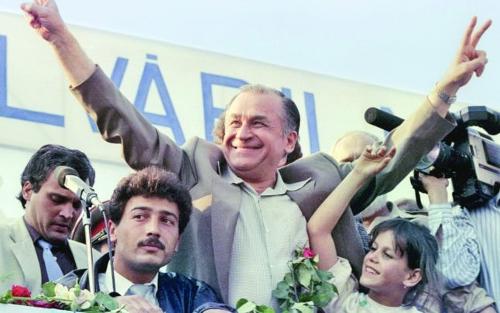 Ion Iliescu in 1990, RomaniaPhoto: Public domain
Ion Iliescu in 1990, RomaniaPhoto: Public domain
In March 1990, serious ethnic riots took place in Târgu Mures, a city with many Romanians and Hungarians, which also resulted in deaths. Students demonstrated against the communists' participation in the elections.
On May 20, 1990, the first free elections were easily won by the FSN led by Ion Iliescu, who was then elected president by an overwhelming majority. However, the students in Bucharest did not simply accept the victory of the FSN and continued to demonstrate. The police were unable to relieve University Square and Iliescu then enlisted the help of miners from the valley of the Jiu River. These intervened very hard at the cost of six deaths and hundreds of injuries, giving Romania a bad image abroad.
On December 8, 1991, a popular referendum was held to approve the new constitution. Yet there were still plenty of problems to solve. In Transylvania, for example, ethnic contrasts continued to dominate the picture and the economic problems in Romania became increasingly greater, partly because trade with the other former Eastern Bloc countries had largely disappeared. Problems had also arisen between President Iliescu and Prime Minister Petre Roman about the pace of reforms.
In 1992 this led to a split within the FSN. The Iliescu supporters formed the Democratic Front of National Salvation (9FDSN), later the Party of Social Democracy in Romania (PDSR). The 1992 elections were won by Iliescu's PDSR and he was elected president a second time. The candidate of the rallied opposition parties, Democratic Convention of Romania (CDR), Emil Constantinescu, was now missing out but defeated Iliescu in the 1996 elections.
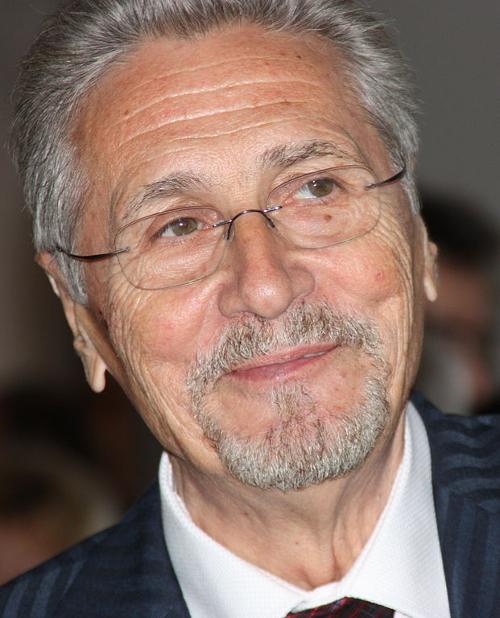 Emil Constantinescu, RomaniaPhoto: Pelz CC 3.0 Unported no changes made
Emil Constantinescu, RomaniaPhoto: Pelz CC 3.0 Unported no changes made
The CDR became the largest party and union leader Victor Ciorbea became prime minister. The people had waited a long time for this, a victory of the democratic opposition over the ex-communists and their nationalist allies. On September 15, 1996, a treaty was concluded between Romania and Hungary, creating a better relationship between Hungary and Romania and between the Hungarian and Romanian populations. However, the economic troubles persisted under Prime Minister Ciorbea's rule. He was soon replaced by Radu Vasile who, however, did not last long and was succeeded by the non-party Mugur Isarescu, the governor of the Romanian National Bank.
21st century
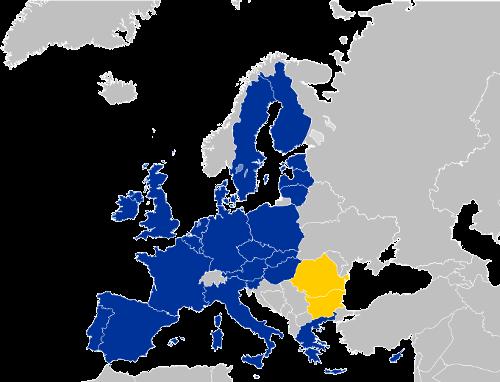 Emil Constantinescu, RomaniaPhoto: Júlio Reis CC 2.5 Generic no changes made
Emil Constantinescu, RomaniaPhoto: Júlio Reis CC 2.5 Generic no changes made
Many Romanian voters blamed President Constantinescu for economic development, but it was still a surprise that he did not make himself available for a second term as President of Romania in the spring of 2000. In the opinion polls, however, he was already well behind his long-standing rival Ion Iliescu.
From 1989 it was clear to Romanians that they wanted to join both the European Union and NATO. In 1995, the aspiration to join the EU was set out in the “Snagov Declaration”, which was signed by all political parties. The first official negotiations with the EU followed in December 1999 and Romania set itself the target of becoming a member of the EU on 1 January 2007.
As far as NATO is concerned, Romania was the first country in 1994 to sign the so-called Partnership for Peace with great enthusiasm from the population. Romania therefore expected an invitation to become a NATO member at a summit in Madrid in 1997. However, this did not happen and that was a serious disappointment for the Romanians, especially since Hungary, Poland and the Czech Republic will be allowed to join in due course.
The parliamentary and presidential elections of November 26, 2000 were a major defeat for the incumbent government of Iliescu. The cooperating parties under the name CDR 2000 did not even reach the electoral threshold, so that the ruling Christian Democratic party did not return to parliament. The PDSR, the largest opposition party, won 40% of the vote and formed a minority government led by Adrian Nastase. The second party was the extreme right-wing party Greater Romania (PRM). The other parties that passed the electoral threshold were the Social Democratic PD, the Hungarian ethnic group UDMR, and the liberal PNL.
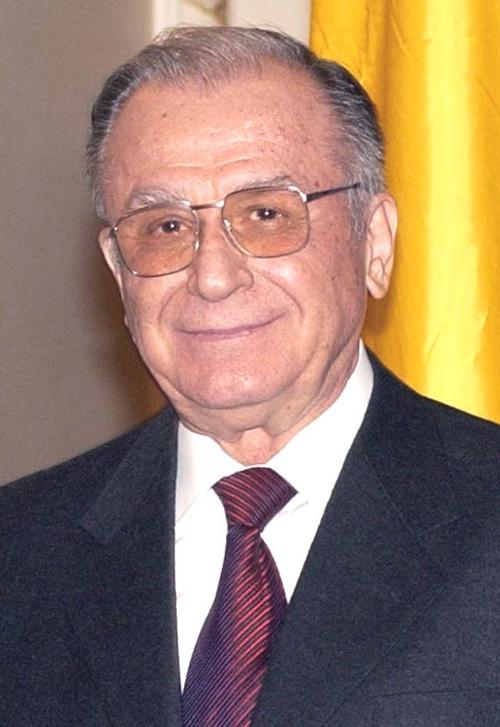 Iliescu in 2004, RomaniaPhoto: Aluísio CC 3.0 Brazil no changes made
Iliescu in 2004, RomaniaPhoto: Aluísio CC 3.0 Brazil no changes made
In the battle for the presidency, it was between the incumbent President Iliescu and the far-right Corneliu Vadim Tudor. Only after a necessary second round on December 10, 2000 did Iliescu score a large majority (65%). Voters felt strongly that they had to choose between two evils, but the danger of becoming internationally isolated prevented Tudor from winning the election. It is to be hoped for Iliescu that Romania's economic situation will improve considerably under his rule. President Iliescu appointed Adrian Nastase Prime Minister in January 2001, who formed a minority government with the support of center-right parties. In May 2001, King Mihai was received by Iliescu and he now lives in Romania again.
The second round of the December 12, 2004 presidential election was won by the mayor of Bucharest, Traian Basescu (Alliance for Justice and Truth, DA). Left-wing Prime Minister Adrian Nastase of the Social Democratic Party (PSD) had won the first round of the elections on November 28, but had less than the required 50% of the vote.
The new president appointed the leader of the Liberal Alliance, Calin Popescu Tariceanu, as formateur. Tariceanu succeeded in forming a majority government and on December 29 this government, consisting of the D.A. Alliance, the UMDR and the PUR, inaugurated. The government has the support of the 18 parliamentarians in the House of Representatives who represent minorities other than the Hungarian. Tensions within the coalition were expressed during the summer of 2005.
In August 2005, Prime Minister Tariceanu reshuffled his government. Five ministers were replaced, namely the Minister of European Integration, the Minister of Finance, the Minister of Health, the Minister of State and the Deputy Prime Minister for Economic Affairs. The coalition, which has now been ruling for more than a year, has now entered calmer waters.
After the November 2008 elections, Napoca Emil Boc will become the new head of government. In 2009 the credit crisis hit Romania hard and the IMF came to the rescue. In October 2009 the Social Democrats leave the coalition. After elections in December, Traian becomes Basescu and Boc forms a new coalition.
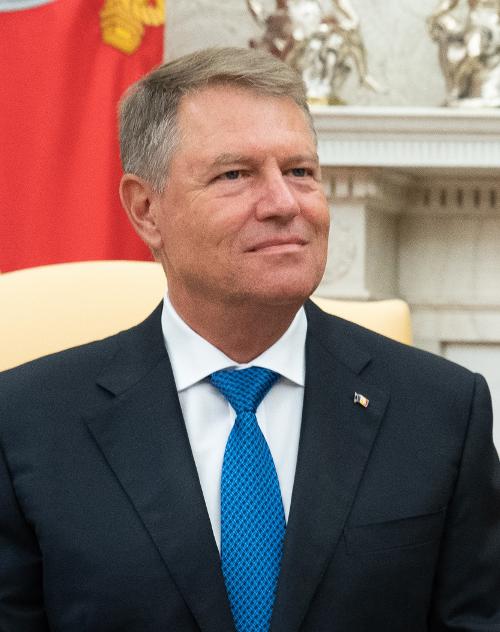 Klaus Iohannes, RomaniaPhoto: Public domain
Klaus Iohannes, RomaniaPhoto: Public domain
Prime Minister of Romania has been Victor-Viorel Ponta since December 12, 2012. In March 2014 he forms a new coalition because the National Liberal Party left the coalition. In November 2014, Klaus Iohannis wins the presidential election and defeats Ponta. In November 2015, Ponta stepped down as prime minister after months of accusations of tax evasion and money laundering, ultimately due to inadequate safety features in a nightclub fire that killed 32 people. Ciolos is in-between as head of a technocratic government until the parliamentary elections in late 2016. In January 2017, Sorin Grindeanu becomes prime minister after a victory of the Social Democrats in the elections. In June 2017 he loses confidence and is succeeded by Mihai Tudose.
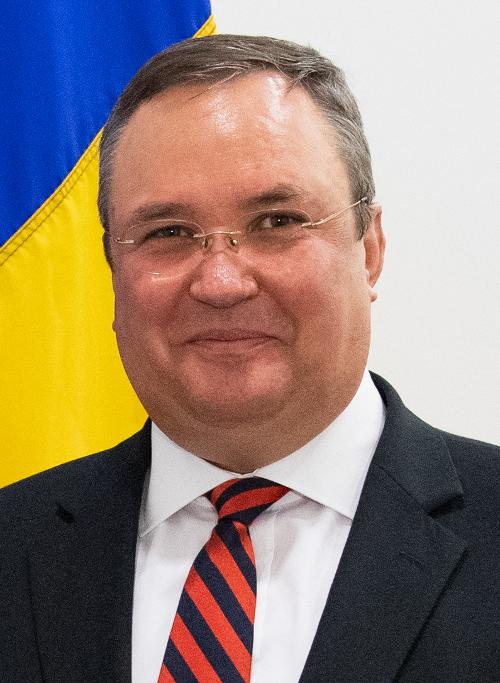 Nicolae-Ionel Ciuca, RomaniaPhoto: U.S. Secretary of Defense CC 2.0 Generic no changes made
Nicolae-Ionel Ciuca, RomaniaPhoto: U.S. Secretary of Defense CC 2.0 Generic no changes made
In November 2019, the Social Democrats lose the confidence of the parliament and Ludovic Orban becomes a middle man the new prime minister. Defense Minister Nicolae-Ionel Ciuca will become acting prime minister in December 2020 following Ludovic Orban's resignation over worse-than-expected election results.
Sources
Bos, J.W. / Roemenië : mensen, politiek, economie, cultuur, milieu
Koninklijk Instituut voor de Tropen
Democratisering aan de Donau : Roemenië na de revolutie van 1989
Instituut voor Publiek en Politiek
Roemenië
Steunpunt Oost-Europa Projecten
Versteegen, J. / Roemenië
Gottmer
Williams, N. / Romania & Moldova
Lonely Planet
CIA - World Factbook
BBC - Country Profiles
Copyright: Team The World of Info